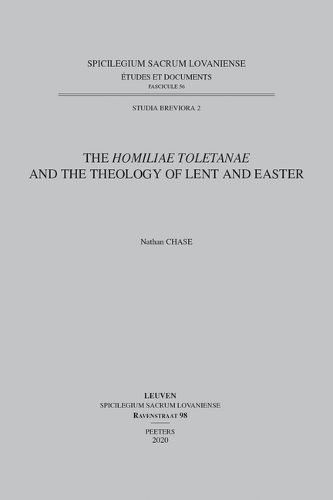Readings Newsletter
Become a Readings Member to make your shopping experience even easier.
Sign in or sign up for free!
You’re not far away from qualifying for FREE standard shipping within Australia
You’ve qualified for FREE standard shipping within Australia
The cart is loading…






This book takes seriously the need for a two-fold shift in methodology
within the field of liturgical studies and serves as a model for future
historical work. The first shift necessary in liturgical studies is a
shift to sources other than the central liturgical texts, i.e. the
Missal, breviary, lectionary, and books of rites. The second shift
necessary in the field is a greater appreciation of the diversity of
liturgical celebrations within the Church. In order to engage in such a
study, this book analyzes a non-traditional liturgical source within a
little-studied liturgical tradition.
The source that provides the
basis for this study is the Homiliae Toletanae (British Library,
Add. 30853), a homiliary for Mass found in the Hispano-Mozarabic Rite.
The Homiliae Toletanae dates to circa the seventh/eighth
centuries and survives in one tenth/eleventh-century manuscript. It
contains homilies for every major temporal and sanctoral feast in the
calendar of Toledo. The Homiliae Toletanae is a valuable
manuscript for reconstructing and understanding the liturgical practices
of seventh/eighth-century Toledo. This study looks only at the Lenten
homilies found within the Homiliae Toletanae in order to
supplement what is already known about the Lenten practices of late
Visigothic and early Mozarabic Spain. In reconstructing the practices of
Lent in seventh/eighth-century Spain, this study explores the two major
themes of Lent, penance and initiation, and their relationship to one
another. It reflects on what some scholars consider a crisis in the
thematic understanding of Lent in the seventh/eighth centuries. Coupled
with this crisis is a shift from adult initiation to infant initiation
in this period. This study argues that this crisis of meaning and the
subsequent shift to a more penitential understanding of Lent was a
direct result of the decline in adult initiation in this period. The
dominant role that fasting and almsgiving played in the Lenten life of
late Visigothic and early Mozarabic Spain is also analyzed.
In
order to conduct this study, this volume utilizes textual criticism as
well as the comparative method in liturgical studies. The comparative
method is based on the work of Anton Baumstark, the Mateos School, and
Paul Bradshaw. This method is used to reconstruct liturgical practices
based on the manuscript evidence. The first part of this book
contextualizes the Homiliae Toletanae within the larger
Hispano-Mozarabic and Christian tradition, and discusses its origin,
dating, composition, and general content. The second part of this book
is an in-depth look at the twenty-three homilies of Lent found within
the Homiliae Toletanae.
The goal of this volume is to show
that liturgical traditions, like the Hispano-Mozarabic Rite, have a
profound creativity and uniqueness. Their patrimony is rich, and they
contain many liturgical insights, both historically and pastorally.
$9.00 standard shipping within Australia
FREE standard shipping within Australia for orders over $100.00
Express & International shipping calculated at checkout
This book takes seriously the need for a two-fold shift in methodology
within the field of liturgical studies and serves as a model for future
historical work. The first shift necessary in liturgical studies is a
shift to sources other than the central liturgical texts, i.e. the
Missal, breviary, lectionary, and books of rites. The second shift
necessary in the field is a greater appreciation of the diversity of
liturgical celebrations within the Church. In order to engage in such a
study, this book analyzes a non-traditional liturgical source within a
little-studied liturgical tradition.
The source that provides the
basis for this study is the Homiliae Toletanae (British Library,
Add. 30853), a homiliary for Mass found in the Hispano-Mozarabic Rite.
The Homiliae Toletanae dates to circa the seventh/eighth
centuries and survives in one tenth/eleventh-century manuscript. It
contains homilies for every major temporal and sanctoral feast in the
calendar of Toledo. The Homiliae Toletanae is a valuable
manuscript for reconstructing and understanding the liturgical practices
of seventh/eighth-century Toledo. This study looks only at the Lenten
homilies found within the Homiliae Toletanae in order to
supplement what is already known about the Lenten practices of late
Visigothic and early Mozarabic Spain. In reconstructing the practices of
Lent in seventh/eighth-century Spain, this study explores the two major
themes of Lent, penance and initiation, and their relationship to one
another. It reflects on what some scholars consider a crisis in the
thematic understanding of Lent in the seventh/eighth centuries. Coupled
with this crisis is a shift from adult initiation to infant initiation
in this period. This study argues that this crisis of meaning and the
subsequent shift to a more penitential understanding of Lent was a
direct result of the decline in adult initiation in this period. The
dominant role that fasting and almsgiving played in the Lenten life of
late Visigothic and early Mozarabic Spain is also analyzed.
In
order to conduct this study, this volume utilizes textual criticism as
well as the comparative method in liturgical studies. The comparative
method is based on the work of Anton Baumstark, the Mateos School, and
Paul Bradshaw. This method is used to reconstruct liturgical practices
based on the manuscript evidence. The first part of this book
contextualizes the Homiliae Toletanae within the larger
Hispano-Mozarabic and Christian tradition, and discusses its origin,
dating, composition, and general content. The second part of this book
is an in-depth look at the twenty-three homilies of Lent found within
the Homiliae Toletanae.
The goal of this volume is to show
that liturgical traditions, like the Hispano-Mozarabic Rite, have a
profound creativity and uniqueness. Their patrimony is rich, and they
contain many liturgical insights, both historically and pastorally.